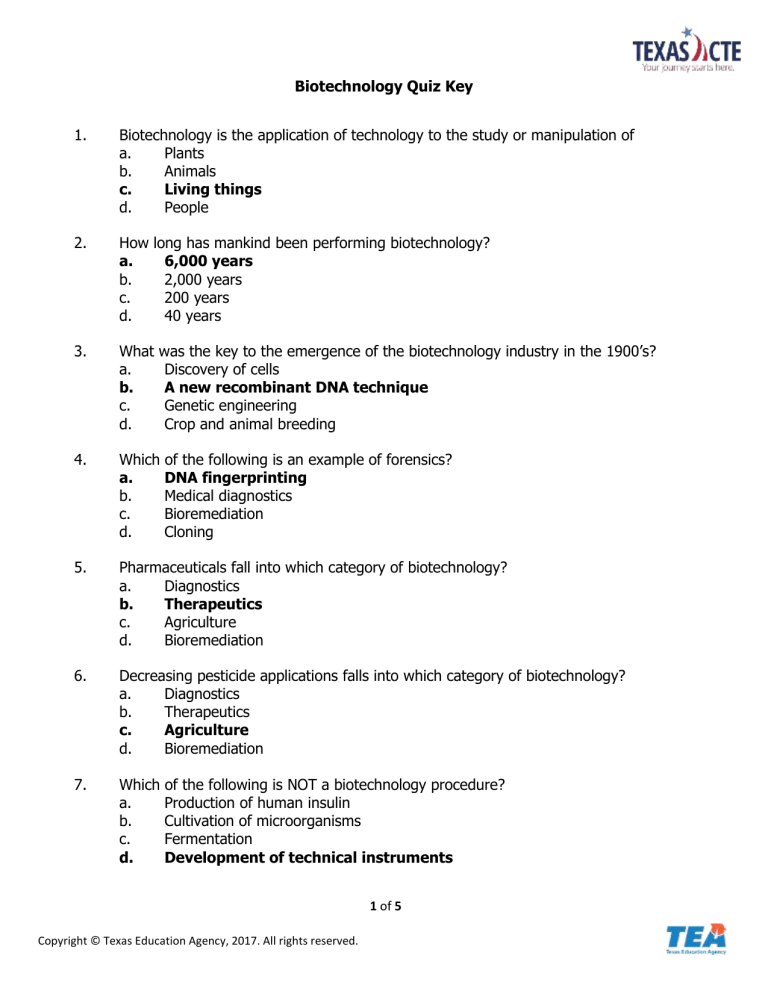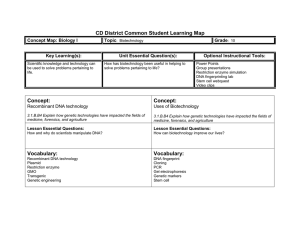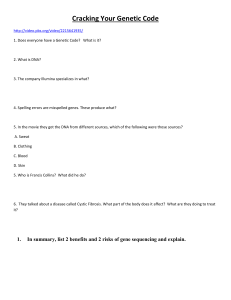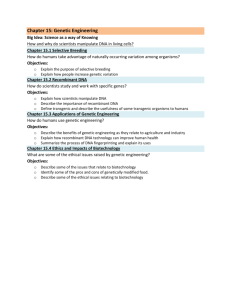
Biotechnology Quiz Key 1. Biotechnology is the application of technology to the study or manipulation of a. Plants b. Animals c. Living things d. People 2. How long has mankind been performing biotechnology? a. 6,000 years b. 2,000 years c. 200 years d. 40 years 3. What a. b. c. d. 4. Which of the following is an example of forensics? a. DNA fingerprinting b. Medical diagnostics c. Bioremediation d. Cloning 5. Pharmaceuticals fall into which category of biotechnology? a. Diagnostics b. Therapeutics c. Agriculture d. Bioremediation 6. Decreasing pesticide applications falls into which category of biotechnology? a. Diagnostics b. Therapeutics c. Agriculture d. Bioremediation 7. Which of the following is NOT a biotechnology procedure? a. Production of human insulin b. Cultivation of microorganisms c. Fermentation d. Development of technical instruments was the key to the emergence of the biotechnology industry in the 1900’s? Discovery of cells A new recombinant DNA technique Genetic engineering Crop and animal breeding 1 of 5 Copyright © Texas Education Agency, 2017. All rights reserved. 8. Which of the following is performed by a bioindustry supplier? a. Specialized software development b. Creating new sources of energy c. Treatment of cancer d. Perform genetic engineering 9. Which of the following is NOT an example of genetic engineering? a. Gene isolation b. Gene modification c. Basic molecular biology d. Develop transgenes 10. Which of the following would be characteristic of an animal rights activist? a. Animals have feelings b. Animals have the same rights as humans c. Experts are reliable and impartial d. Concern about environmental consequences 11. Which of the following would be characteristic of a biomedical researcher? a. Animals don’t have feelings b. Animals have no rights c. Experts are reliable and impartial d. No concern about environmental consequences 12. Which of the following is an example of xenotransplantation? a. Kidney donation from a father to a son b. Using stem cells to treat cancer c. Cloning a pet d. Using a pig heart valve to treat heart disease 13. Which of the following court ruling made DNA patentable? a. Diamond vs. Chakrabarty b. Brown vs. Board of Education c. Scopes monkey trial d. Roe vs. Wade 14. Which of the following needs to be considered from an ethical standpoint? a. Gene isolation b. Production of human insulin c. Animal research d. Products that cure or reduce the incidence of disease 15. Which of the following is a laboratory technique used by scientists to change the DNA of living organisms? a. Molecular biology 2 of 5 Copyright © Texas Education Agency, 2017. All rights reserved. b. c. d. Genetic engineering Cloning Immunology 16. Which of the following is a class of undifferentiated cells that are able to differentiate into specialized cell types? a. Stem cells b. Interferon c. Recombinant DNA d. Genetics 17. Which of the following is a test to identify and evaluate the genetic information called DNA in a person's cells? a. Genetic engineering b. DNA fingerprinting c. Recombinant DNA d. Immunology 18. What is a gene? a. A region of DNA that controls a hereditary characteristic. b. The transplantation of living cells, tissues or organs from one species to another, such as from pigs to humans. c. A naturally occurring substance that interferes with the ability of viruses to reproduce. d. An organism whose genetic material has been altered using genetic engineering techniques. 19. Who discovered the DNA molecular structure? a. George Washington Carver b. Louis Pasteur c. James Watson and Francis Crick d. Linus Pauling 20. Who was the only person who has won two undivided Nobel Prizes? a. George Washington Carver b. Louis Pasteur c. James Watson and Francis Crick d. Linus Pauling 21. List several biotechnology fields. Genetic engineering Environmental technology o Ecology and environmental problems o Bioremediation 3 of 5 Copyright © Texas Education Agency, 2017. All rights reserved. Crop and animal breeding Medicine o Diagnostics o Pharmaceuticals o Nutrition Forensics 22. What is bioremediation? It involves using biotechnology-designed organisms to clean up oil or other spills. 23. Why do we use animals in biotechnology research? Animals are biologically similar to humans. They are susceptible to many of the same health problems, and they have short life-cycles so they can easily be studied throughout their whole life-span or across several generations. In addition, scientists can easily control the environment around the animal (diet, temperature, lighting, etc.), which would be difficult to do with people. However, the most important reason why animals are used is that it would be wrong to deliberately expose human beings to health risks in order to observe the course of a disease. 24. Where do we use fermentation? We use fermentation in brewing, baking, and cheese production. 25. Describe ethical analysis. 1. Formulation of the dilemma; 2. Finding out the possible options of action in this situation; 3. Assignment of the optional actions to values that are touched by the action and reflection of the consequences; 4. Taking a justified decision for one of the options of action in respect to the reflections in step 3; 5. Assignment of the decision taken to one of the two higher categories of argumentation; 6. Description and discussion of the consequences of the decision taken in step 4 for the individual and for the society. 4 of 5 Copyright © Texas Education Agency, 2017. All rights reserved. 5 of 5 Copyright © Texas Education Agency, 2017. All rights reserved.




